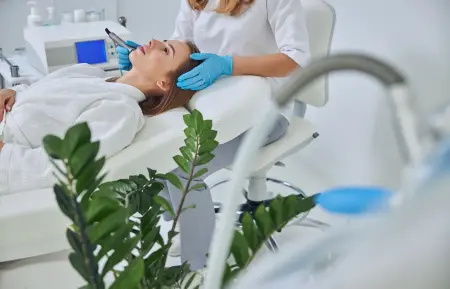GMC Registered Doctors
Expert Diagnosis & Care
Personalised Management
Tailored Information & Plans
Effective Clearing Options
Minimally Affecting Techniques
CQC Regulated Clinic
Safe & Professional Environment
Understanding Sebaceous Cysts: Definition, Causes, and Development
Sebaceous cysts (also called epidermoid cysts) are common, benign skin growths that develop when a hair follicle or skin pore becomes blocked. These closed sacs beneath the skin fill with a soft, cheese-like substance composed of dead skin cells and oils. Most commonly appearing on the face, neck, trunk, and genital region, sebaceous cysts typically grow slowly and are painless unless they develop microbial issues or become inflamed.
At Revitalise London, our GMC registered doctors provide expert assessment and information about sebaceous cysts and their management options. Our CQC-regulated Harley Street clinic delivers comprehensive care focused on both health and aesthetic considerations.
The Science Behind Sebaceous Cysts: Formation and Development
Understanding how sebaceous cysts develop helps comprehend this common skin condition:
Cysts form when normal skin processes are disrupted:
- Epidermoid Cysts (Most Common): Surface skin cells move deeper instead of shedding, multiply, and produce keratin (cheese-like substance).
- Pilar Cysts: Develop from hair follicles (common on scalp), contain a more liquid substance.
- True Sebaceous Cysts (Less Common): Originate from oil glands, contain oily material.
Several factors may influence formation:
- Blocked Follicles: Caused by skin trauma, acne, cell turnover issues, swollen follicles.
- Genetic Factors: Predisposition in some families or conditions (e.g., Gardner’s syndrome).
- Hormonal Influences: May stimulate oil glands.
- Environmental Factors: Sun exposure, certain products, occupational exposures may play a role.
Our doctors can discuss potential contributing factors in your case.
Identifying Sebaceous Cysts: Characteristics and Differentiation
Proper identification is important to distinguish cysts from other skin growths:
Common Characteristics of Sebaceous Cysts
- Dome-shaped, smooth lump under the skin.
- Slow-growing, usually painless unless experiencing microbial issues/inflammation.
- Firm to soft texture, movable under the skin.
- Size varies (millimetres to centimetres).
- May have a small central pore (punctum).
- Can occasionally discharge thick, foul-smelling material.
Differentiating from Other Skin Growths
- Lipomas: Softer, deeper, contain fat, no central pore.
- Abscesses: Painful, red, warm, rapid onset, contain pus (microbial issue).
- Acne Cysts: More inflammatory, painful, red, associated with acne.
- Dermatofibromas: Firmer, often darker, less mobile.
Our GMC registered doctors provide accurate diagnosis through careful assessment.
When to Seek Professional Assessment for Sebaceous Cysts
While often harmless, professional evaluation is recommended if a cyst:
Medical Reasons
- Shows signs of microbial issues (pain, redness, warmth, swelling).
- Grows rapidly.
- Has unusual features (atypical appearance, colour change, irregular border).
- Repeatedly ruptures or drains.
- Interferes with function (movement, vision).
Aesthetic Considerations
- Located in a visible area (face, neck).
- Large size causing cosmetic concern.
- Presence of multiple cysts.
Our doctors assess both medical and aesthetic aspects to guide recommendations.
Professional Sebaceous Cyst Assessment: What to Expect
Our assessments by GMC registered doctors are comprehensive:
A thorough discussion and examination covering:
- Detailed medical history (cyst onset, changes).
- Discussion of symptoms (pain, drainage).
- Comprehensive examination of the cyst and skin.
- Palpation to assess mobility and consistency.
- Measurement of dimensions.
- Assessment for signs of inflammation/microbial issues.
Evaluation Techniques:
- Visual & Tactile Examination: Identifying key characteristics.
- Dermoscopy: Magnified view of surface features (e.g., central pore).
- Transillumination (occasionally): Using light to assess contents.
- Ultrasound (if needed): For complex/atypical cases to visualise structure.
Personalised Assessment Findings Discussion:
- Confirmation of diagnosis.
- Assessment of size, location, inflammation.
- Evaluation of growth pattern (active vs. stable).
- Identification of complications (e.g., microbial issues).
- Recommendation of appropriate management options.
We prioritise patient education throughout the process.
Sebaceous Cyst Management: Comprehensive Information
Various approaches exist, tailored to size, location, symptoms, and patient preference by our GMC registered doctors.
Management Approaches Overview
Professional sebaceous cyst management may include:
- Observation: Monitoring small, asymptomatic, non-concerning cysts.
- Incision and Drainage: Releasing contents of cysts with microbial issues/inflammation for relief (cyst wall remains, high recurrence risk).
- Complete Cyst Clearing Procedure: Definitive clearing of the cyst and its entire wall under local anaesthetic to prevent recurrence.
- Minimal Access Techniques: Specialised approaches aiming for smaller incisions in cosmetically sensitive areas.
All procedures are performed by GMC registered doctors in our CQC-regulated facility, prioritising safety, effectiveness, and aesthetics.
Potential Outcomes and Recovery
Understanding the process helps set expectations:
- Recovery: Most return to normal activities quickly, often within days.
- Healing: Area may be tender initially; complete healing typically within 1-2 weeks.
- Long-term Results: Complete clearing significantly minimises recurrence risk at the site.
- Aftercare: Simple wound care instructions are provided.
Our doctors provide detailed, personalised aftercare guidance.
Home Care & Prevention Strategies
Guidance on managing cysts at home and reducing risk:
Managing Sebaceous Cysts at Home
Appropriate Home Care:
- Keep the area clean with mild soap and water.
- Avoid Manipulation: Do NOT squeeze, pop, or pick at cysts – risk of microbial issues, inflammation, scarring.
- Apply clean, warm compresses for mild discomfort (10-15 mins, several times daily).
- Use over-the-counter pain relief if needed for mild discomfort.
When Home Care Is Not Enough (Seek Professional Help):
- Increasing pain, redness, warmth, or swelling (signs of microbial issues).
- Fever or chills develop.
- Cyst ruptures spontaneously (needs proper wound care).
Prevention and Risk Reduction
Preventive Strategies:
- Maintain good skin hygiene, especially in prone areas.
- Use gentle skincare products; avoid harsh scrubbing.
- Manage acne effectively.
- Protect skin from trauma where possible.
Risk Reduction for Existing Cysts:
- Monitor cysts regularly for changes.
- Protect cysts in friction-prone areas (padding, clothing).
- Seek early assessment for signs of microbial issues or significant growth.
Our GMC registered doctors offer personalised advice on home care and prevention.
Why Choose Revitalise London for Sebaceous Cyst Management?
Expert dermatological care in a safe, professional, CQC-regulated environment.
Dedicated Expertise and Patient-Centred Care
Choosing the right clinic for sebaceous cyst assessment and clearing is important for both health and cosmetic outcomes. At Revitalise London, we prioritise accurate diagnosis, safe procedures, and patient satisfaction.
Exceptional Medical Expertise
Our GMC registered doctors have specialised training in dermatology and minor procedures, skilled in techniques minimising scarring.
CQC Regulated Clinic (‘Good’ Rating)
We adhere to the highest standards of safety, clinical governance, hygiene protocols, and data protection, ensuring quality care.
State-of-the-Art Facilities
Our Harley Street clinic utilises advanced diagnostic tools and has fully equipped procedure rooms for optimal results.
Patient-Centred Approach
We offer unhurried consultations, clear explanations, shared decision-making, comprehensive aftercare, and dedicated support.

Frequently Asked Questions About Sebaceous Cysts
Answers to common queries about cysts and their management.
Generally benign (non-harmful). They don’t pose serious health risks unless they develop microbial issues or become inflamed (pain, redness, swelling), which requires medical attention. Rarely, a lump might be misidentified, so professional assessment is valuable for certainty.
They typically form from blocked hair follicles or skin pores, often due to minor skin trauma, acne, or disruptions in cell turnover. Genetics can also play a role. Our doctors can discuss potential factors in your case.
Rarely. Sebaceous cysts usually persist or grow slowly. Spontaneous rupture might occur, but the cyst wall often remains, leading to refilling. Complete clearing is typically needed for permanent resolution.
This is strongly discouraged. Attempting to squeeze or drain a cyst at home can lead to microbial issues, increased inflammation, scarring, and incomplete clearing (leading to recurrence). Professional management ensures safety and effectiveness.
Signs of microbial issues include increasing pain, redness spreading around the cyst, warmth, swelling, tenderness, and potentially pus discharge or fever. Seek prompt medical assessment if you suspect microbial issues.
Any procedure involving skin clearing can leave a mark. Our doctors use techniques to minimise scarring. The final appearance depends on cyst size/location, clearing method, and individual healing. We discuss realistic outcomes during consultation.
Recurrence at the *same site* is rare if the entire cyst wall is successfully cleared. However, new cysts can develop elsewhere if you have a predisposition.






